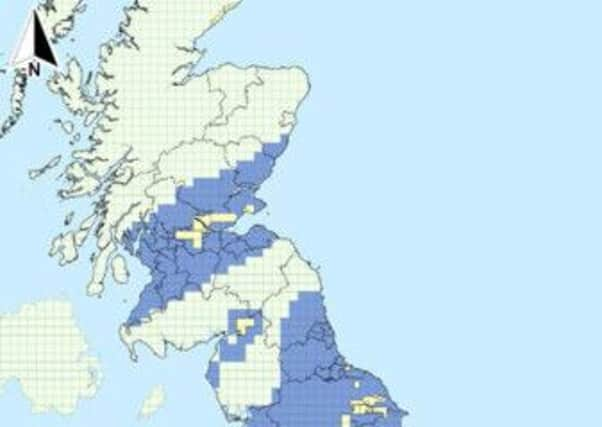Fracking map of Scotland revealed by UK ministers


In a report and map published yesterday, the Department for Energy and Climate Change (DECC) announced the next stage of shale gas exploration – fracking – which has led to protests in the south of England.
The report steps up the UK government’s support for shale gas, claiming large-scale production could create thousands of jobs and inject almost £1 billion into local communities.
Advertisement
Hide AdAdvertisement
Hide AdMinisters published a “regulatory roadmap” for shale gas, setting out the permits developers need before drilling.
The report, produced for the government by engineering giant Amec, set out the potential effects of shale oil and gas
production.
Energy minister Michael Fallon said: “There could be large amounts of shale gas available in the UK, but we won’t know for sure the scale of this prize until further exploration takes place.
“This marks the next step in unlocking the potential of shale gas in our energy mix. It is an exciting prospect which could bring growth, jobs and energy security.
“But we must develop shale responsibly, both for local communities and for the environment, with robust regulation in place.”
However, the UK government admitted that high levels of shale gas production could adversely affect the environment through increased traffic and pressure on water resources.
The Scottish Government has already tightened planning rules to make it harder for fracking to take place north of the Border, but the report and map published yesterday by DECC revealed exploration in Scotland formed an important part of its plans.
The report came in for strong criticism from opposition parties and environmental groups.
Advertisement
Hide AdAdvertisement
Hide AdMary Church, head of campaigns at Friends of the Earth Scotland, said: “Communities across Scotland will be alarmed to discover that despite growing evidence about the harmful impacts of unconventional gas drilling and fracking, the UK government is determined to go ahead with plans to squeeze as much as they can out of some of the most populated parts of the country.”
Greenpeace campaigner Anna Jones said: “Michael Fallon is desperate to put a positive spin on this report, but what it actually shows is that the government wants to open two-thirds of England up to fracking, with all the associated risks.
“Up to 18 per cent of all mains water could be used, enough waste water to fill 40,000
Olympic-sized swimming pools created, and tiny villages could experience up to 50 truck movements a day.
“Fallon has also ignored the report’s lower jobs estimate, which is just 2,500.”
Tom Greatrex, Labour’s shadow energy minister and MP for Rutherglen and Hamilton West, said: “Rather than focusing on the need for robust regulation and comprehensive monitoring to address legitimate environmental concerns, the government seems to prefer to give licence to those who make simplistic comparisons to the USA that don’t stand up to scrutiny.
“Rather than relishing a false argument with opponents of fracking, the government should be taking a responsible approach – leading rather than posturing.”
A Scottish Government spokeswoman said: “We strongly endorse the appropriate and robust regulation of drilling techniques such as hydraulic fracturing [fracking] associated with the extraction of shale gas.
Advertisement
Hide AdAdvertisement
Hide Ad“The minister for environment and climate change recently announced a strengthening of planning policy in relation to unconventional gas – showing that this government listens to local communities and to those calling for stronger environmental protection.”
SEE ALSO: